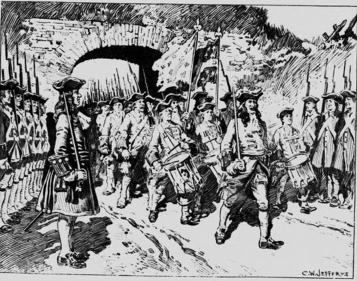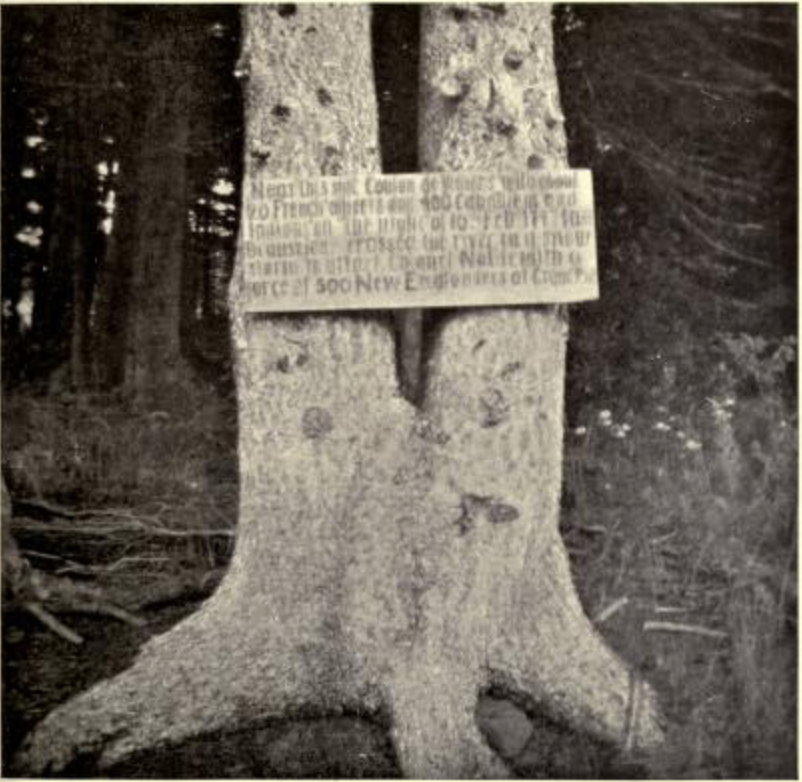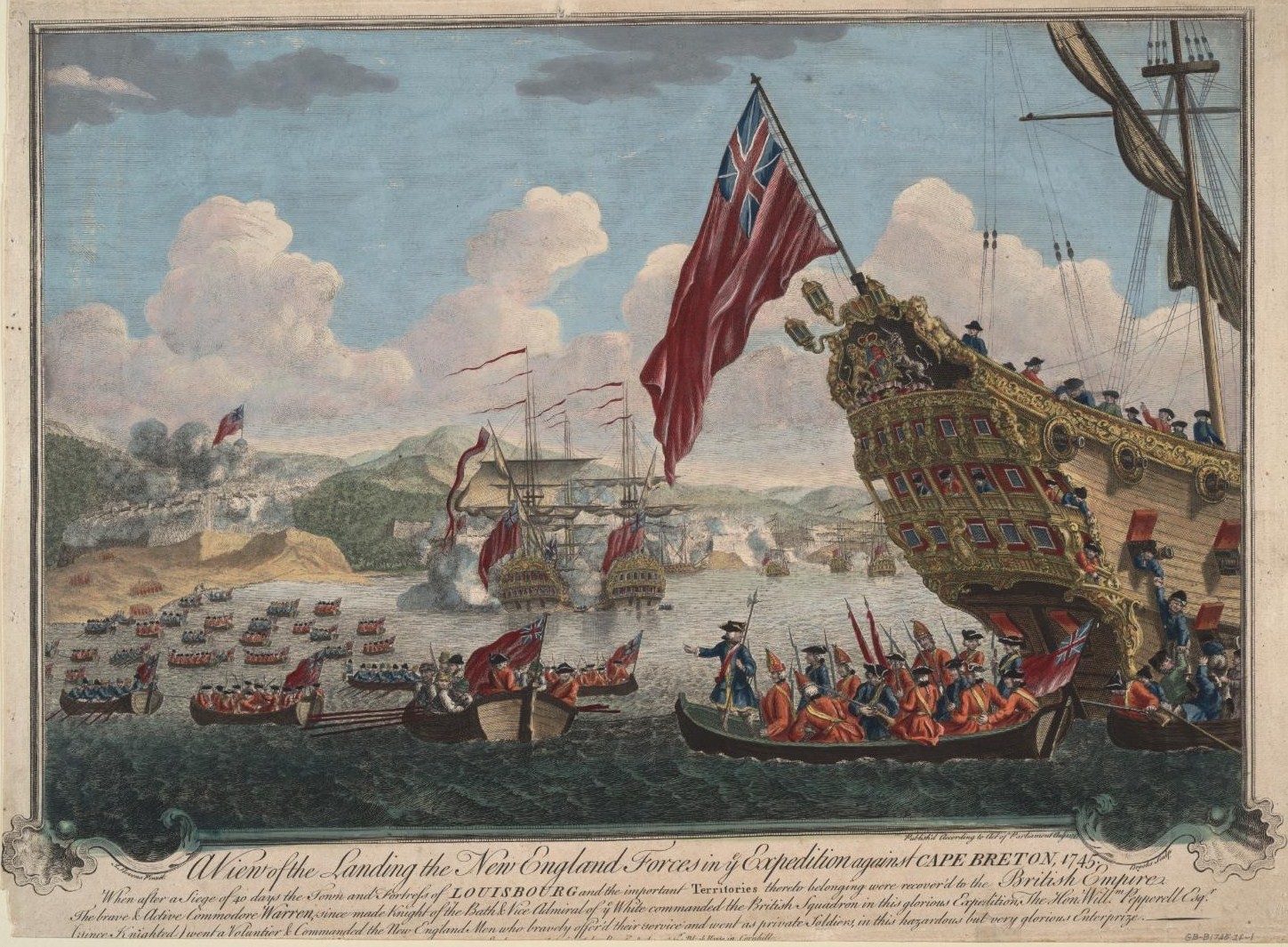 |
Indian Brook 14
Indian Brook 14 is a Mi'kmaq reserve located in Hants County, Nova Scotia. In the 2016 Census, the reserve has 1,089 residents. It is administratively part of the Sipekneꞌkatik First Nation. History Father Louis-Pierre Thury sought to gather the Mi'kmaq of Peninsular Nova Scotia into a single settlement around Shubenacadie Nova Scotia as early as 1699. Not until Father Rale's War, however, did Antoine Gaulin, a Quebec-born missionary, erect a permanent mission at Shubenacadie (adjacent to Snides Lake and close to the former Residential school). He also make seasonal trips to Cape Sable, LaHave, and Mirlegueche. The Shubenacadie mission's dedication to Saint Anne speaks to a spirit of accommodation on the part of both the French and the Mi'kmaq. Anne, traditionally identified as the mother of Mary, was the grandmother of Jesus himself. The esteemed position of grandmothers in Mi'kmaw society was a point of agreement between Roman Catholicism and the Mi'kmaw worldview, ... [...More Info...] [...Related Items...] OR: [Wikipedia] [Google] [Baidu] |
 |
Nova Scotia
Nova Scotia ( ; ; ) is one of the thirteen provinces and territories of Canada. It is one of the three Maritime provinces and one of the four Atlantic provinces. Nova Scotia is Latin for "New Scotland". Most of the population are native English-speakers, and the province's population is 969,383 according to the 2021 Census. It is the most populous of Canada's Atlantic provinces. It is the country's second-most densely populated province and second-smallest province by area, both after Prince Edward Island. Its area of includes Cape Breton Island and 3,800 other coastal islands. The Nova Scotia peninsula is connected to the rest of North America by the Isthmus of Chignecto, on which the province's land border with New Brunswick is located. The province borders the Bay of Fundy and Gulf of Maine to the west and the Atlantic Ocean to the south and east, and is separated from Prince Edward Island and the island of Newfoundland (island), Newfoundland by the Northumberland Stra ... [...More Info...] [...Related Items...] OR: [Wikipedia] [Google] [Baidu] |
 |
Father Le Loutre's War
Father Le Loutre's War (1749–1755), also known as the Indian War, the Mi'kmaq War and the Anglo-Mi'kmaq War, took place between King George's War and the French and Indian War in Acadia and Nova Scotia. On one side of the conflict, the British and New England colonists were led by British officer Charles Lawrence and New England Ranger John Gorham. On the other side, Father Jean-Louis Le Loutre led the Mi'kmaq and the Acadia militia in guerrilla warfare against settlers and British forces. At the outbreak of the war there were an estimated 2500 Mi'kmaq and 12,000 Acadians in the region. While the British captured Port Royal in 1710 and were ceded peninsular Acadia in 1713, the Mi'kmaq and Acadians continued to contain the British in settlements at Port Royal and Canso. The rest of the colony was in the control of the Catholic Mi'kmaq and Acadians. About forty years later, the British made a concerted effort to settle Protestants in the region and to establish military ... [...More Info...] [...Related Items...] OR: [Wikipedia] [Google] [Baidu] |
|
Indian Reserves In Nova Scotia
Indian or Indians may refer to: Peoples South Asia * Indian people, people of Indian nationality, or people who have an Indian ancestor ** Non-resident Indian, a citizen of India who has temporarily emigrated to another country * South Asian ethnic groups, referring to people of the Indian subcontinent, as well as the greater South Asia region prior to the 1947 partition of India * Anglo-Indians, people with mixed Indian and British ancestry, or people of British descent born or living in the Indian subcontinent * East Indians, a Christian community in India Europe * British Indians, British people of Indian origin The Americas * Indo-Canadians, Canadian people of Indian origin * Indian Americans, American people of Indian origin * Indigenous peoples of the Americas, the pre-Columbian inhabitants of the Americas and their descendants ** Plains Indians, the common name for the Native Americans who lived on the Great Plains of North America ** Native Americans in ... [...More Info...] [...Related Items...] OR: [Wikipedia] [Google] [Baidu] |
|
 |
Jean-Baptiste Cope
Jean Baptiste Cope (Kopit in Mi’kmaq meaning ‘beaver’) was also known as Major Cope, a title he was probably given from the French military, the highest rank given to Mi’kmaq. Cope was the sakamaw (chief) of the Mi'kmaq people of Shubenacadie, Nova Scotia ( Indian Brook 14, Nova Scotia/ Mi’kma'ki). He maintained close ties with the Acadians along the Bay of Fundy, speaking French and being Catholic. During Father Le Loutre’s War, Cope participated in both military efforts to resist the British and also efforts to create peace with the British. During the French and Indian War he was at Miramichi, New Brunswick, where he is presumed to have died during the war. Cope is perhaps best known for signing the Treaty of 1752 with the British, which was upheld in the Supreme Court of Canada in 1985 and is celebrated every year along with other treaties on Treaty Day (October 1). Father Rale's War Cope was born in Port Royal and the oldest child of six. During Father R ... [...More Info...] [...Related Items...] OR: [Wikipedia] [Google] [Baidu] |
|
Daniel N
Daniel is a masculine given name and a surname of Hebrew origin. It means "God is my judge"Hanks, Hardcastle and Hodges, ''Oxford Dictionary of First Names'', Oxford University Press, 2nd edition, , p. 68. (cf. Gabriel—"God is my strength"), and derives from two early biblical figures, primary among them Daniel from the Book of Daniel. It is a common given name for males, and is also used as a surname. It is also the basis for various derived given names and surnames. Background The name evolved into over 100 different spellings in countries around the world. Nicknames ( Dan, Danny) are common in both English and Hebrew; "Dan" may also be a complete given name rather than a nickname. The name "Daniil" (Даниил) is common in Russia. Feminine versions ( Danielle, Danièle, Daniela, Daniella, Dani, Danitza) are prevalent as well. It has been particularly well-used in Ireland. The Dutch names "Daan" and "Daniël" are also variations of Daniel. A related surname de ... [...More Info...] [...Related Items...] OR: [Wikipedia] [Google] [Baidu] |
|
 |
American Indian Movement
The American Indian Movement (AIM) is a Native American grassroots movement which was founded in Minneapolis, Minnesota in July 1968, initially centered in urban areas in order to address systemic issues of poverty, discrimination, and police brutality against Native Americans. AIM soon widened its focus from urban issues to many Indigenous Tribal issues that Native American groups have faced due to settler colonialism in the Americas. These issues have included treaty rights, high rates of unemployment, Native American education, cultural continuity, and the preservation of Indigenous cultures. AIM was organized by Native American men who had been serving time together in prison. They had been alienated from their traditional backgrounds as a result of the United States' Public Law 959 Indian Relocation Act of 1956, which supported thousands of Native Americans who wanted to move from reservations to cities, in an attempt to enable them to have more economic opportunities for ... [...More Info...] [...Related Items...] OR: [Wikipedia] [Google] [Baidu] |
|
Anna Mae Aquash
Annie Mae Aquash (Mi'kmaq name ''Naguset Eask'') (March 27, 1945 – mid-December 1975 ) was a First Nations activist and Mi'kmaq tribal member from Nova Scotia, Canada. Aquash moved to Boston in the 1960s and joined other First Nations and Indigenous Americans focused on education and resistance, and police brutality against urban Indigenous peoples. She was part of the American Indian Movement, participated in several occupations, and participated in the 1973 Wounded Knee incident at the Pine Ridge Indian Reservation, United States. Aquash also participated in the 1972 Trail of Broken Treaties and occupation of the Department of Interior headquarters in Washington, DC. In the following years, Aquash was active in protests to draw positive government action and acknowledgement of First Nations and Native American civil rights in Canada and Wisconsin. After Aquash disappeared in late December 1975, there were rumors she had been killed. An FBI report by Special Agent David Pr ... [...More Info...] [...Related Items...] OR: [Wikipedia] [Google] [Baidu] |
|
 |
French And Indian War
The French and Indian War (1754–1763) was a theater of the Seven Years' War, which pitted the North American colonies of the British Empire against those of the French, each side being supported by various Native American tribes. At the start of the war, the French colonies had a population of roughly 60,000 settlers, compared with 2 million in the British colonies. The outnumbered French particularly depended on their native allies. Two years into the French and Indian War, in 1756, Great Britain declared war on France, beginning the worldwide Seven Years' War. Many view the French and Indian War as being merely the American theater of this conflict; however, in the United States the French and Indian War is viewed as a singular conflict which was not associated with any European war. French Canadians call it the ('War of the Conquest').: 1756–1763 The British colonists were supported at various times by the Iroquois, Catawba, and Cherokee tribes, and the French ... [...More Info...] [...Related Items...] OR: [Wikipedia] [Google] [Baidu] |
 |
Expulsion Of The Acadians
The Expulsion of the Acadians, also known as the Great Upheaval, the Great Expulsion, the Great Deportation, and the Deportation of the Acadians (french: Le Grand Dérangement or ), was the forced removal, by the British, of the Acadian people from parts of a Canadian-American region historically known as ''Acadia'', between 1755–1764. The area included the present-day Canadian Maritime provinces of Nova Scotia, New Brunswick, and Prince Edward Island, and the present-day U.S. state of Maine. The Expulsion, which caused the deaths of thousands of people, occurred during the French and Indian War (the North American theatre of the Seven Years' War) and was part of the British military campaign against New France. The British first deported Acadians to the Thirteen Colonies, and after 1758, transported additional Acadians to Britain and France. In all, of the 14,100 Acadians in the region, approximately 11,500 were deported, at least 5,000 Acadians died of disease, starvat ... [...More Info...] [...Related Items...] OR: [Wikipedia] [Google] [Baidu] |
 |
Battle Of Grand Pré
The Battle of Grand Pré, also known as the Battle of Minas and the Grand Pré Massacre, was a battle in King George's War that took place between New England forces and Canadian, Mi'kmaq and Acadian forces at present-day Grand-Pré, Nova Scotia in the winter of 1747 during the War of the Austrian Succession. The New England forces were contained to Annapolis Royal and wanted to secure the head of the Bay of Fundy. Led by Nicolas Antoine II Coulon de Villiers and Louis de la Corne, Chevalier de la Corne under orders from Jean-Baptiste Nicolas Roch de Ramezay, the French forces surprised and defeated a force of British troops, Massachusetts militia and rangers that were quartered in the village. Background Grand Pré had been the staging ground for the French and Mi'kmaq sieges of Annapolis Royal in 1744 and 1745. As a result, New England Ranger John Gorham demanded to take control of Grand Pré after the first siege in 1744 and again after the second. The French made ... [...More Info...] [...Related Items...] OR: [Wikipedia] [Google] [Baidu] |
 |
Mi'kmaq People
The Mi'kmaq (also ''Mi'gmaq'', ''Lnu'', ''Miꞌkmaw'' or ''Miꞌgmaw''; ; ) are a First Nations people of the Northeastern Woodlands, indigenous to the areas of Canada's Atlantic Provinces and the Gaspé Peninsula of Quebec as well as the northeastern region of Maine. The traditional national territory of the Mi'kmaq is named Miꞌkmaꞌki (or Miꞌgmaꞌgi). There are 170,000 Mi'kmaq people in the region, (including 18,044 members in the recently formed Qalipu First Nation in Newfoundland.) Nearly 11,000 members speak Miꞌkmaq, an Eastern Algonquian language. Once written in Miꞌkmaw hieroglyphic writing, it is now written using most letters of the Latin alphabet. The Mi'kmaq, Maliseet, and Pasamaquoddy nations signed a series of treaties known as the Covenant Chain of Peace and Friendship Treaties with the British Crown throughout the eighteenth century; the first was signed in 1725, and the last in 1779. The Miꞌkmaq maintain that they did not cede or give up the ... [...More Info...] [...Related Items...] OR: [Wikipedia] [Google] [Baidu] |
 |
King George's War
King George's War (1744–1748) is the name given to the military operations in North America that formed part of the War of the Austrian Succession (1740–1748). It was the third of the four French and Indian Wars. It took place primarily in the British provinces of Province of New York, New York, Province of Massachusetts Bay, Massachusetts Bay (which included Maine as well as Massachusetts at the time), Province of New Hampshire, New Hampshire (which included Vermont at the time), and Nova Scotia. Its most significant action was an expedition organized by Massachusetts Governor William Shirley that Siege of Louisbourg (1745), besieged and ultimately captured the French fortress of Louisbourg, on Cape Breton Island in Nova Scotia, in 1745. In French language, French, it is known as the ''Troisième Guerre Intercoloniale'' or Third Intercolonial War. The Treaty of Aix-la-Chapelle (1748), Treaty of Aix-la-Chapelle ended the war in 1748 and restored Louisbourg to France, but fail ... [...More Info...] [...Related Items...] OR: [Wikipedia] [Google] [Baidu] |